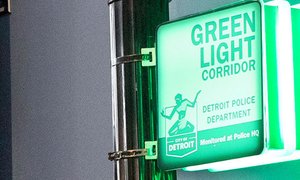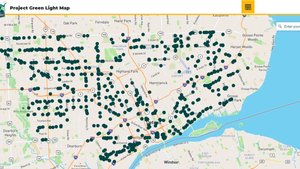Notes on Project Green Light

A big concern for surveillance oversight advocates is the ever expanding role of the private sector in issuing and monetizing surveillance technology, analytical tools, and the selling of data itself. This trend is obvious in spaces that we visit all the time, like corporate run entertainment districts that have their own camera systems and private security—LA Live and Hudson Yards come to mind. But what about parts of other cities that aren’t so heavily invested and don’t have a corporate security benefactor? How does the privatization of public safety figure into those places? Detroit, a city that has struggled to maintain investment interest outside of its downtown core has attempted to address a lack of policing capability throughout the rest of the city. To tackle this, they introduced a first of its kind, controversial initiative: Project Green Light.
Project Green Light (PGL) is an initiative by the Detroit Police where partner organizations (largely liquor stores, gas stations, convenience stores, and apartment buildings) purchase cameras from the city that are installed on their property. These cameras, then, collect live-feed footage for the Detroit Police to directly access in real time. Partners enter into a contract with the city where they cover the up-front cost of installing new, high quality cameras (usually $2k-$4k) and pay monthly data fees to have their footage streamed to the Police (usually $150-$200 per month). You can spot a partner organization by its blinking green lights and required signage that discloses their participation in the program. The visibility of a green light is now a visual queue of security, as they prominently blink atop participating business.
For partner organizations, the Detroit Police vows to ensure “calls for service at Project Green Light locations are categorized as priority one.” For a city with an average police response time of 14.5 minutes (compared to 7.7 minutes in New York, which is middle-of-the-pack when it comes to response time), this is quite the offer. As a Detroit civil rights attorney and surveillance oversight advocate tells me, a pay-for-service model of policing is effectively “legalized racketeering”—what is in theory a public good becomes something that is instead offered in exchange for security footage.

According to the city, Project Green Light is the “first public-private-community partnership of its kind, blending a mix of real-time crime-fighting and community policing aimed at improving neighborhood safety, promoting the revitalization and growth of local businesses.” The last part of that description is significant: the city of Detroit sees a clear link between surveillance and the economic development outside of the already thriving downtown core. In fact, when Chief of Police James Craig, who initiated Project Green Light, was instated, he was described by then-Mayor Bing as someone who could use the power of policing as an economic development tool, because “that’s how we rebuild a tax base. That’s how we bring the city of Detroit back”
Many of the concerns around Project Green Light have been raised by organizations like the Detroit Justice Center and Green Light Black Futures center on the use (and misuse) of surveillance footage. While police aim to utilize PGL footage for crimes like robberies and hit and runs, the technology may also include the use of facial recognition software that has misidentified Detroiters–like Robert WIlliams–resulting in wrongful arrest. Beyond wrongful arrest, the footage gathered from PGL is shared in public meetings and social media. Images of individuals allegedly committing crimes caught on the feed—even when charges are still pending or the accused have not yet been apprehended—often show up on the PGL’s Twitter feed (worth a look for its large catalog of images of the accused that raise questions about due process).
In researching PGL, one question seems to come up repeatedly: Does it work? Does the knowledge that a live feed of footage at certain marked locations will be sent straight to the police department deter crime? The answer to this depends on who you ask. The Detroit Police have claimed that the start of PGL coincides with a drop in violent crime, but the Department of Justice has released a report showing that there is no significant change in crime. A Michigan State University study by Dr. Giovanni Circo and his research group reported that there was no drop in violent crime in Detroit that could be attributed to PGL (there was actually an increase in overall crime, though they attribute this to increased reporting). While the partner organizations that I talked to throughout my research have consistently reported that they have experienced significantly reduced response times and some have experienced a reduction in crime, specifically theft and armed robbery, I’m not compelled. Crime rates can be studied and metrics can be compared, but when technology is being used in a way that places over surveilled populations at further risk, does it even matter if it “works”?

What’s so new about this? The answer is nothing—and everything. PGL certainly continues trends in policing and surveillance technology. For one, it speaks to an emerging trend in law enforcement of deputizing both civilians and the private sector to save costs. When every citizen is a cop, then policing escapes democratic scrutiny in favor of unregulated, privatized, tech-driven solutions. You’re likely familiar with these technologies and maybe even use yourself—Ring cameras or apps like Citizen and NextDoor.
But there is also a new twist on this trend brought on by PGL: surveillance is no longer just about promoting public safety, it’s tied up in a city’s economic development goals. PGL is a clear example of the role of policing and surveillance in supporting new development and potentially gentrification. Numerous partners I spoke with described PGL as an effective way to attract business from customers who feel safe under the blinking green lights—a stated goal of the initiative. Some explicitly noted that this feeling of safety was a way to attract clientele from affluent Detroit suburbs. Planners should be interested in the use of surveillance technology and its ability to create “safe” consumer spaces for some while generating legitimate legal threats for others.
PGL raises important questions, particularly in gentrifying and changing neighborhoods. How do policing and the justice system play a supportive role in urban development that we should be skeptical of? How does this role help to select out certain people from what is ‘desired’ in newly developed spaces? How does the relationship between development agendas and law enforcement present a threat to democracy? Put simply: Who truly feels safe under the green light?
Now, in our city, we elected a police chief as Mayor during an economic recession and are experiencing a post-pandemic drive to revive the real estate market—where will we draw the line between policing and economic development?
Circo, Giovanni, and Edmund McGarrell. 2021. “Estimating the Impact of an Integrated CCTV Program on Crime.” Journal of Experimental Criminology 17 (1): 129–50.